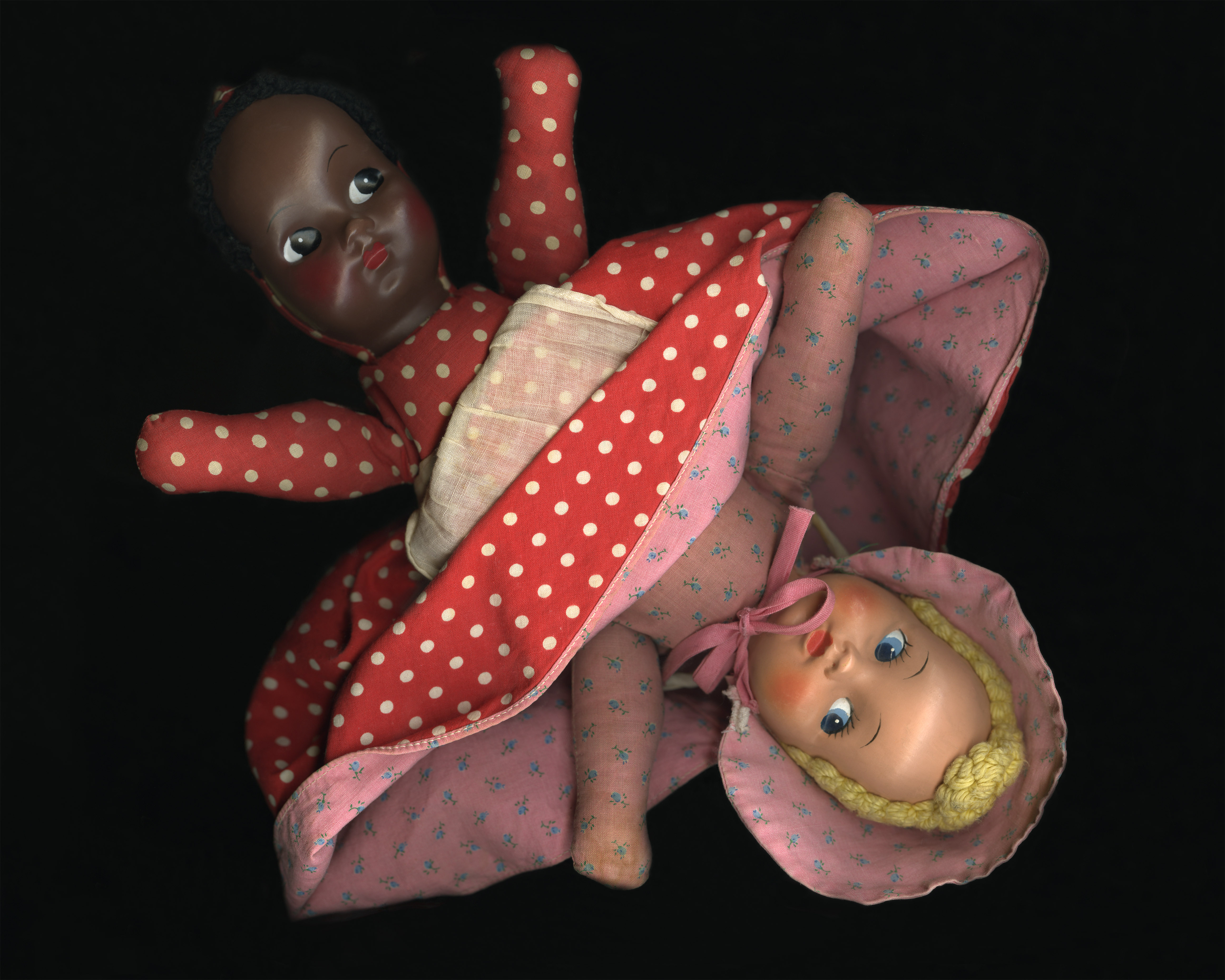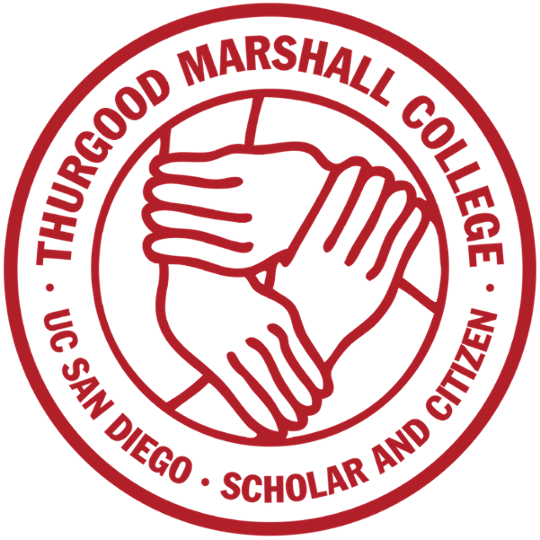Public Arts Initiative
The Public Arts Initiative at Thurgood Marshall College is dedicated to bringing artists specializing in all forms to the UC San Diego campus in order to exhibit new work on the Marshall campus.
The Bright Spot
Katherine Steelman is a PhD student in Ethnic Studies. Her current project examines the effects of US cultural production on the development of queer space in Tijuana, MX, as well as the Tijuanense response to the US’s narrative of the city and it’s queer communities. This work juxtaposes critical analyses of cultural texts with ethnographic interviews.
Patricia Zambrano is a student in the Visual Arts MFA program. Her photographic and video work interrogates notions of time, space, place and sexuality in the US/Mexico Borderlands.
Read about The Bright Spot here.
Real American Progress
Real American Progress
This community based public mural is in three sections reflecting the three DOC concentrations of Past/Diversity, Present/Justice and Future/Imagination.The right wall, Past/Diversity, is about death and destruction and the tragedies experienced by people of color throughout US history due to white supremacy. We must never forget. The middle wall, Present/Justice, is about the fight for justice, the understanding that we can and must fight for systemic change. The left wall, Future/Imagination, is about hope and success resulting in a world that is beautiful. If you dream the impossible it can come true, it will come true. We must always believe that we can make the world a better place.
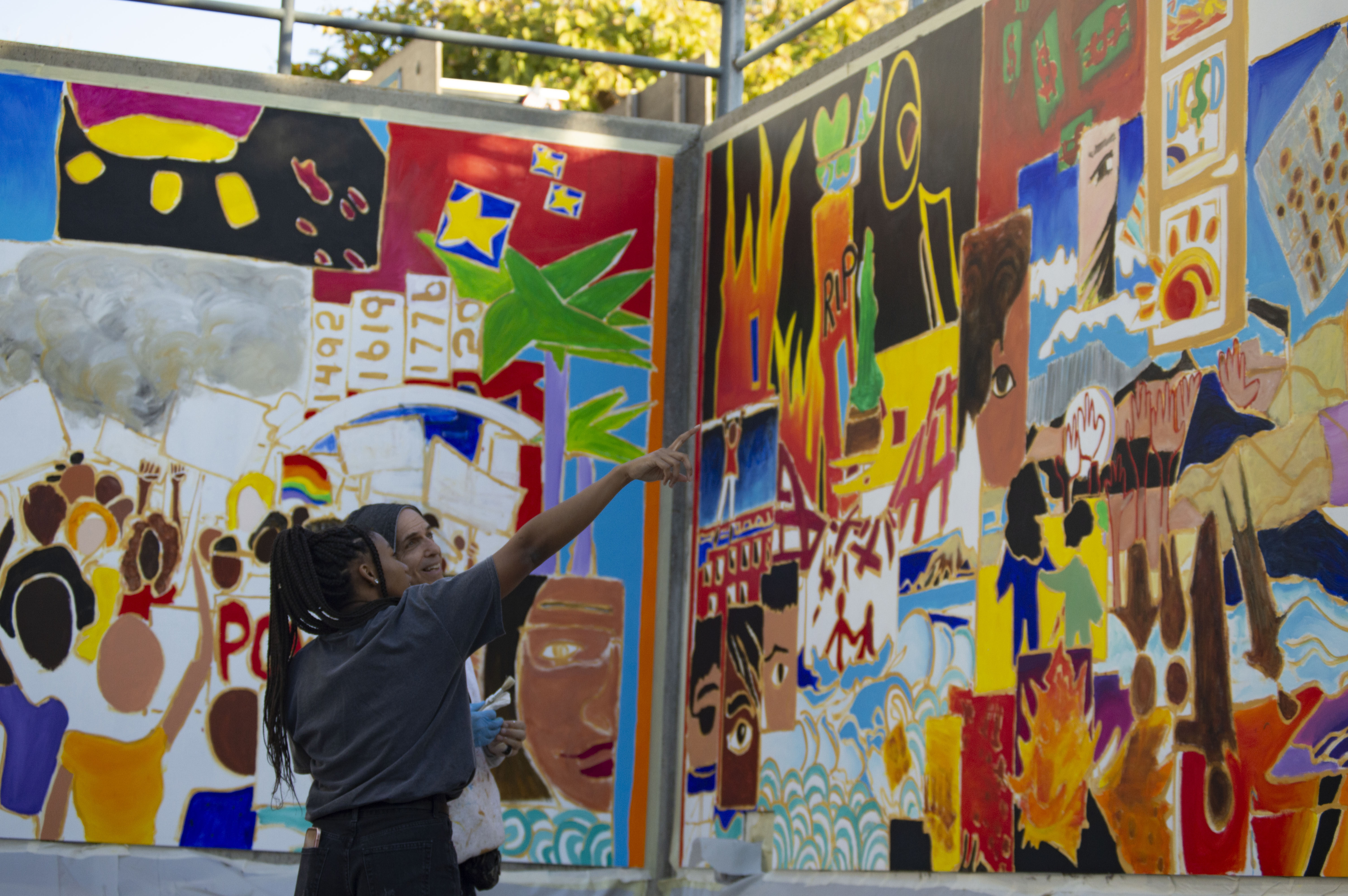 There are two other inspiring themes that weave through the work. One is the faces of you, the student- the diversity of our Marshall student body as first proclaimed in the Lumamba Zapata Doctrine. The second are images of the Kumeyaay tribe and history. We should always remember that they were here first, are still here in this area of the country and are actually going through an amazing renaissance. This campus this spot of the mural, was their land, their sacred land. By honoring the Kumeyaay and the Lumumba Doctrine this land of Thurgood Marshall College at UCSD becomes our sacred land.
There are two other inspiring themes that weave through the work. One is the faces of you, the student- the diversity of our Marshall student body as first proclaimed in the Lumamba Zapata Doctrine. The second are images of the Kumeyaay tribe and history. We should always remember that they were here first, are still here in this area of the country and are actually going through an amazing renaissance. This campus this spot of the mural, was their land, their sacred land. By honoring the Kumeyaay and the Lumumba Doctrine this land of Thurgood Marshall College at UCSD becomes our sacred land.
The title was inspired by two different sources. American Progress was a vicious racist propaganda painting from the 1870s that promoted and encouraged white supremacy versus the “savagery” of the other. The second part of the title was written by one of the Marshall College design workshop participants.
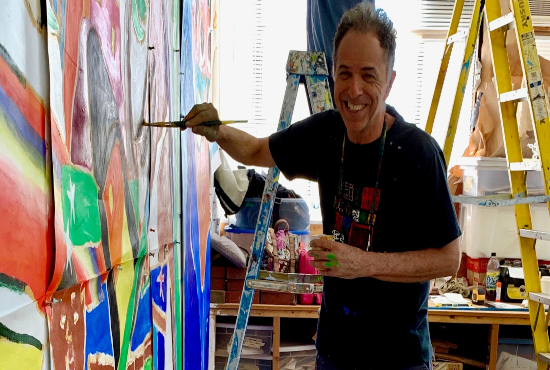 Jay Wolf Schlossberg-Cohen, an American artist based out of Baltimore and San Diego, was selected as the 2019-20 TMC Artist in Residence. He visited campus to facilitate a series of design workshops that helped develop visual ideas for a new outdoor mural in Voice Courtyard.
Jay Wolf Schlossberg-Cohen, an American artist based out of Baltimore and San Diego, was selected as the 2019-20 TMC Artist in Residence. He visited campus to facilitate a series of design workshops that helped develop visual ideas for a new outdoor mural in Voice Courtyard.
Sojourner Truth
Sojourner Truth
The newest public art installation Sojourner Truth, is the latest creation of sculptor and UCSD alumna Manuelita Brown, 76.’ The large bronze statue portrays African-American abolitionist and women's rights activist, Sojourner Truth in a life-sized cast bronze statue. The statue standing beside UCSD’s Ridge Walk, a busy pedestrian pathway, is six feet tall and exudes Truth's deep humanity and commitment to education and action in the pursuit of equal rights. The statue was unveiled at an official campus ceremony on January 22, 2015.
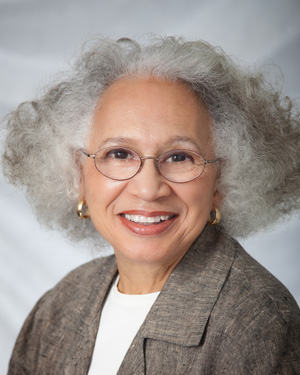 Manuelita Brown, '76 is an artist specializing in bronze figurative and portrait sculpture. Sculpting in her own studio, she creates portraits of noted African Americans and other everyday people in figurative realism for bronzes that she personally supervises from her original clay sculpture through the lost wax casting process. Other works include the Thurgood Marshall Bust and Triton Statue for UC San Diego. Her artwork has been exhibited in juried shows nationally and won a number of awards and is included in many private collections and several museums. She has completed private, corporate, and public commissions. Ms. Brown was an educator at UCSD for many years before dedicating herself full-time to her art.
Manuelita Brown, '76 is an artist specializing in bronze figurative and portrait sculpture. Sculpting in her own studio, she creates portraits of noted African Americans and other everyday people in figurative realism for bronzes that she personally supervises from her original clay sculpture through the lost wax casting process. Other works include the Thurgood Marshall Bust and Triton Statue for UC San Diego. Her artwork has been exhibited in juried shows nationally and won a number of awards and is included in many private collections and several museums. She has completed private, corporate, and public commissions. Ms. Brown was an educator at UCSD for many years before dedicating herself full-time to her art.
Sojourner Truth [1797-1883] was born Isabella Baumfree and later gave herself the name Sojourner Truth in 1843. Born into slavery she eventually escaped with her infant daughter to freedom in 1826. After going to court to recover her son, she became the first black woman to win such a case against a white man. Her best-known extemporaneous speech on gender inequalities, "Ain't I a Woman?", was delivered in 1851 at the Ohio Women's Rights Convention in Akron, Ohio. During the Civil War, Truth helped recruit black troops for the Union Army and tried to secure land grants from the federal government for former slaves. Truth’s writings are a regular part of the current Dimensions of Culture Program required of all Marshall College freshman students.
Topsy-Turvy
Topsy-Turvy
Angela Jennings recieved her MFA from UC San Diego researching modes of hierarchical systems encompassing race, knowledge, material and gender. Her art practice is distinct despite being transcribed through interdisciplinary acts. The mural was unveiled at a public ceremony Fall 2014.
Mural
The Topsy-Turvy mural is a signifier of dichotomies. The high resolution scan of the 1950’s topsy-turvy doll printed on scrim tarpaulin material bolted loosely to a corner on Solis Hall performs dualities of stratification. The materiality of the tarp paired with the installation submit to notions of banners and advertising; placards which are not traditional concepts found in Muralism. This juxtaposition sets the Topsy-Turvy Tarp a whirl.
The topsy-turvy doll itself is an object that is sutured at the waist, designed to give a person two options of play. The options allotted in this specific topsy-turvy doll purchased off of EBay includes two girls; their faces are identical made from the same mold, but their implied race and social standings are drawn from the histories of black and white race relations within the United States and elsewhere. The white doll wears a sun bonnet to protect her skin along with a pink dress embroidered with small delicate flowers. On the flipside attached is a black doll who wears a red and white striped dress along with a white apron. The dress is shared mutually serving its purpose as both a garment and a curtain; concealing either the black or white doll depending on which one is held upright or being played with.
The connection this particular topsy-tuvy doll makes to Thurgood Marshall is found in the Kenneth and Mamie Clark’s Doll Test. The Doll Test results were one of the contributing pieces of evidence Marshall used while working as a lawyer on the 1954 Supreme Court case Brown vs. Board of Education, which deemed segregation in public schools to be unconstitutional. The Doll Test was given to children attending segregated schools in Washington DC along with children enrolled in integrated schools in New York. The test involved presenting each child with two identical dolls except for hair and skin color; one doll was white with yellow hair and the other was brown with black hair. The child was then asked to complete a series of tasks and questions including:
- Give me the doll that you like to play with the best.
- Give me the doll that is a nice doll.
- Give me the doll that looks bad.
- Give me the doll that is a nice color.
- Give me the doll that looks like a white child.
- Give me the doll that looks like a colored child.
- Give me the doll that looks like a Negro child.
- Give me the doll that looks like you.
The results showed a racial preference for the white dolls over black, and validated the internalized self-hatred among black children within segregated schools. The arrangement of the topsy-turvy doll illustrates both past and present circumstances of separatism. Through the gesture of Hands Up taken from the Ferguson Uprising, the black doll holds her arms above her head in surrender while the white doll commands a stance of control. The Topsy-Turvy mural functions in a state of protest against the realities of separatism, false ideologies and prevailing prejudice, waiting for one day when biased beliefs will turn.
* Solis Hall was named after the second provost of Thurgood Marshall College Faustina Solis, who was an advocate of social justice. Solis established education, housing and public health care programs for migrant workers. As provost, Solis also supported and designed mentoring programs for underrepresented members of the student body.
Martin Luther King & 37th Street
Martin Luther King & 37th Street
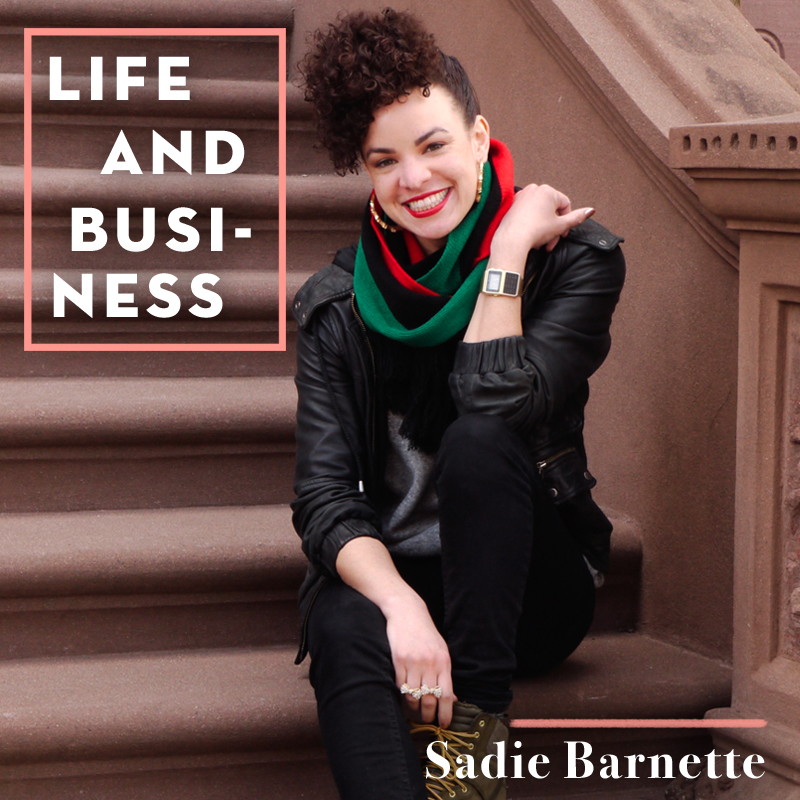 Sadie Barnette is from Oakland, California. She received her BFA from CalArts in 2006, and her Masters in Visual Arts at the University of California, San Diego, in 2012. Barnette was a 2014-15 Artist-in-Residence at Studio Museum in Harlem. She has shown her work in venues including The Mistake Room, Self Help Graphics, Charlie James, and Papillion in Los Angeles, Ever Gold Gallery in San Francisco, Studio Museum in Harlem, and Goodman Gallery in Johannesburg, South Africa.
Sadie Barnette is from Oakland, California. She received her BFA from CalArts in 2006, and her Masters in Visual Arts at the University of California, San Diego, in 2012. Barnette was a 2014-15 Artist-in-Residence at Studio Museum in Harlem. She has shown her work in venues including The Mistake Room, Self Help Graphics, Charlie James, and Papillion in Los Angeles, Ever Gold Gallery in San Francisco, Studio Museum in Harlem, and Goodman Gallery in Johannesburg, South Africa.
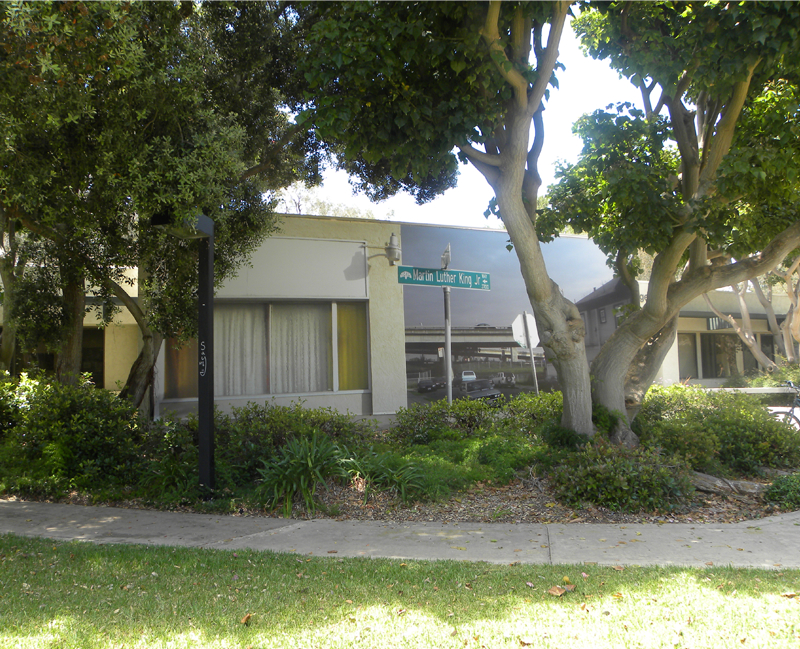 Martin Luther King & 37th Street mural is a large mural meausuring 13'x35' located on the Thurgood Marshall College Administration Building. The mural was commissioned by the college as part of the 40th anniversary celebrations. The mural is at first not a mural at all but an optical illusion that transports us to another place entirely. While standing at the entrance to the Thurgood Marshall Administration building, we are confronted by a giant image of a city street corner – the corner of Martin Luther King, Jr. Blvd & an anonymous urban street. The street is still and empty, cast in a quiet light, perhaps for a moment of contemplation. A freeway in the distance transports people through and away from the city, almost up into the gray-blue sky.
Martin Luther King & 37th Street mural is a large mural meausuring 13'x35' located on the Thurgood Marshall College Administration Building. The mural was commissioned by the college as part of the 40th anniversary celebrations. The mural is at first not a mural at all but an optical illusion that transports us to another place entirely. While standing at the entrance to the Thurgood Marshall Administration building, we are confronted by a giant image of a city street corner – the corner of Martin Luther King, Jr. Blvd & an anonymous urban street. The street is still and empty, cast in a quiet light, perhaps for a moment of contemplation. A freeway in the distance transports people through and away from the city, almost up into the gray-blue sky.
A street sign bearing the name of Martin Luther King, Jr. is both a familiar image and a multi-layered symbol. It is an homage to the man himself, to the haunting speeches, the march on Washington, the Dream, to the turbulent 1960’s – humanity at its best and worst. The presence of the street sign is evidence of the decades of organizing and lobbying to formalize Martin Luther King memorials, the renaming of city streets, and the establishment of his birthday as a recognized holiday. The sign also evokes the rich history and narrative of Thurgood Marshall College itself, as Martin Luther King was considered a possible name for the college as it sought to form its identity. Today, streets bearing the name of Martin Luther King, Jr. weave through our cities, bearing witness to the tensions, the violence, the vibrancy, the sounds – music, sirens, the stories of our urban America as we struggle to live up to the Dream.
The Boat, El Barco

UCSD MFA alumna, Robin Sanford Roberts is a theatrical scenic designer and artist working in models and mixed media. She has designed for Broadway, Old Globe Theatre, San Diego Rep, Arizona Theatre Company, San Jose's Repertory and Swine Palace Productions. She is a recipient of the prestigious NEA/Theatre Communications Group Grant. Ms. Roberts has received both San Diego Critics and Patté awards for 'outstanding scenic design'.
Ms. Roberts created a unique art installation titled The Boat, El Barco, a meditation on the perils of open water migration between Mexico and the United States in April 2011 in celebration of the college's 40th anniversary year.
